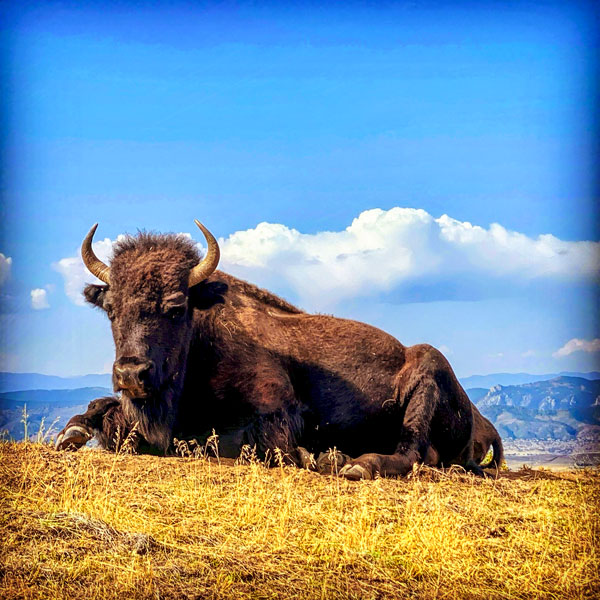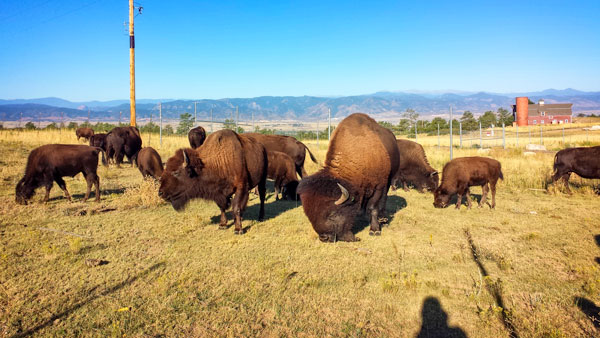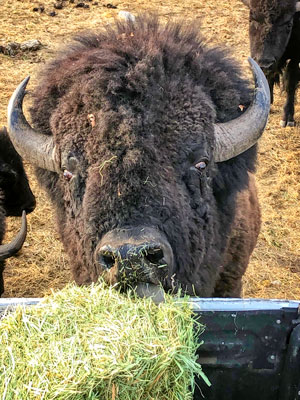Oh, give me a home …
By Lynn Zahorik; photo courtesy of Julie Lamb

Saturday, November 7 is National Bison Day in honor of the majestic animal’s significance in American history. The Castle Pines community is fortunate to live minutes from the bison herd in Daniels Park, bearing witness to its strength, resilience and beauty. In this issue, we celebrate all things buffalo and bison.
Joining the ranks of the American bald eagle as an official symbol of our country, the American bison was named the national mammal of the U.S. in 2016 to recognize its historical, cultural and economic importance.
According to the American Bison Society, bison were “integrally linked with the economic and spiritual lives of many Native American tribes through trade and sacred ceremonies.” Bison also play an important role in soil improvement and plant growth, spreading native seeds and helping to maintain a healthy and balanced ecosystem.
At one time, tens of millions of North American bison roamed freely throughout the U.S. By the late 1800s, their number had been reduced to fewer than 500, the result of overhunting and the popularity of bison hide trading. The formation of the American Bison Society by Theodore Roosevelt (and others) in 1905, along with continued conservation efforts, has gradually brought the number of bison located throughout North America back to approximately 500,000, most of which are privately owned.

Castle Pines residents look forward to the birth of spring calves each year. (Photo by Lynn Zahorik)
The Denver Mountain Parks system owns and manages two herds. One is located in Genesee Park off of Interstate 70, a 40-minute drive from Castle Pines. Residents are fortunate to have the other mountain herd as neighbors. These bison call the grassy buttes and ravines in Daniels Park, just west of the Castle Pines community, home.
The Daniels Park herd is maintained and cared for by Senior Park Ranger Ryan Phillian, who lives on the property. The herd consists of 48 bison – two bulls, 26 cows and 20 calves that were born this spring. According to Phillian, the most impressive bison in the herd is Rawhide, a fully mature bull that, at 10 years of age, is 6 feet tall and weighs approximately 2,000 pounds. Rawhide is joined by 5-year-old Florence, who is a slightly smaller bull. They are the only two males in the herd for breeding.
Female cows weigh up to 1,000 pounds and reach a height of 4 to 5 feet. They traditionally have one calf each year in the spring. Their gestation period is similar to humans at around nine and a half months. Calves can range in weight but typically average 50 pounds. At birth, bison are orange-red in color, earning them the nickname of “red dogs.”
The Daniels Park herd roams the 1,000 acres of preserved Daniels Park land year-round, grazing on vegetation and grasses. They are rotated to various portions of the park’s pastures as needed. The bison do not have access to a barn or a sheltered facility other than the native landscape, and their burly bodies are well adapted for the chilly months of the year. In the winter and early spring, the bison’s diet is supplemented with hay. As the cold sets in, an average of 12 to 18, 60-pound bales of hay are distributed daily to the bison. When spring arrives, the herd must be pared down to a sustainable level for the given pasture and parkland and to make room for the new season of calves. The previous year’s calves are auctioned off each March to ranchers from around the country at the annual auction at Genesee Bison Ranch.

Rawhide, the herd’s largest bull, is helping himself to a bite. In the winter months when grazing is scarce, the herd is supplemented with bales of hay. (Photo courtesy of Ryan Phillian, Daniels Park bison herd caretaker)
Denver got into the bison herd business when the city was looking to purchase bison for the city zoo. In 1914, seven of Yellowstone National Park’s last wild bison herd were brought to Colorado. The vision was to connect the Denver Mountain Parks system’s 47 foothill and mountain parks via scenic drives, providing recreational mountain resources within easy reach for Denver residents. Originally, the park at Genesee was planned as a wild animal zoo of sorts, providing a home to pronghorns, elk, mountain sheep, deer and bison. Over time, it was the bison that survived and eventually grew to include the herd in Daniels Park.
The bison at Daniels Park are arguably one of the Castle Pines community’s most unique attributes. Visiting Daniels Park affords residents the rare opportunity to experience these magnificent beasts.
For more information about Denver Mountain Parks, visit denvergov.org. For more information about bison, visit nps.gov/subjects/bison/visit.htm.